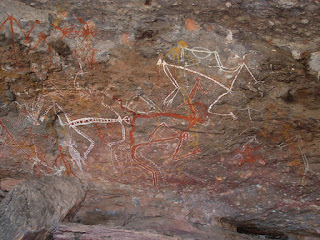After all my travel, money was getting tight and I was fortunate to
fall into employment almost immediately. Right place, right time. I
became a waiter at a seafood restaurant called The Jetty. It was a
popular eatery in the city, partly because of its great value buffet
and partly because of its location. The alfresco dining area was a
deck that sat over the water with views of Darwin harbour and out to
the Timor Sea. On a typical warm evening, it made the ideal place to
enjoy a meal while watching storm clouds building and lightening
flashing on the horizon.
 |
| Outdoor deck of The Jetty restaurant |
Ideal for the restaurant patrons anyway. For us, it was usually
bloody hard work especially if it was a Friday or Saturday night.
Diners helped themselves to food from the buffet while we were flat
out bringing them drinks and clearing tables. All I could think in
those busiest moments was that at least I wasn’t slaving away in
the kitchen washing dishes! In some small way, at I’d managed to
move up in the world and I have to say that the meal we were given
each night was better than Gilligan’s!
So with evening employment organised, I still had plenty of time
during the day to explore the city and its surrounds. The central
point of Darwin is the pedestrian Smith St Mall from where it’s a
relatively short walk to the waterfront precinct. Aside from coming
down here late afternoon each day for work, it was also I good place
for fishing and catching sea breezes. A good walk that I always
enjoyed was the path through Bicentennial Park that follows the
foreshore to a point called Doctors Gully.
 |
| Rebuilt church with original facade |
A highlight of Darwin is the Northern Territory Museum and Art
Gallery. These galleries include a superbly presented collection of
aboriginal art, including paintings from nearby Arnhem Land and
carvings from the Tiwi Islands. Cyclone Tracy ripped through the
city in 1974 and an entire room is devoted to graphically
illustrating the devastation of that day. On my visit I got a photo
of Sweetheart: a 5 metre long, 780kg salt water crocodile that
attacked fishing dinghies on the Finniss River.
My home away from home was a wonderful hostel called the Wilderness
Lodge. I loved my time there because the staff quickly became my
friends and it wasn’t long before I joined them. My job in the
morning was to clean the place in return for my weekly accommodation.
There were a few others who were using it as their home while
working in Darwin so we were given a room of our own. It always
seemed to be in a shambles but it was always somewhere to relax and
have a few laughs.
 |
| Wilderness Lodge hostel |
A perk of working at the hostel was that I could borrow a bike
whenever I needed it. Darwin is great for cycling and a series of
bike tracks covers much of the city. Several times I did a sunset
ride out to East Point Reserve spit to watch wallabies emerging to
feed and the sun sinking into Fannie Bay. This ride goes past Mindil
Beach which has an excellent night market during the dry season.
Aside from the stalls selling all kinds of food, art, craft and
clothing, I loved the rhythmic sounds of bands combining the
traditional didgeridoo with contemporary music.
Also on the way to East Point is the old Fannie Bay Gaol. Like
Melbourne’s old gaol, it is a grim but interesting insight into
nearly 100 years of penal history. I took time to visit one weekend
and learned about the prisoners that were held and the crimes they
had committed to be there. Also on view are the gallows where two of
them were hung in 1952. Later in the day I continued in a slightly
different direction to an area called Nightcliff and Casuarina Beach.
While Darwin is no beach paradise, the attraction of this particular
stretch of sand is that it’s an official nude beach.
 |
| Mindil Beach night markets |
One day between my two jobs I took a bike 5km out to the Charles
Darwin National Park. This park offers a network of paths that
explore wetlands, woodlands and some WWII bunkers. (There are some
other intriguing reminders of WWII in Darwin including oil storage
tunnels, gun emplacements and the military museum that commemorates
Australia’s only wartime attack.) From the park lookout there is a
sweeping view over the mangroves and across Frances Bay to the
skyline of the city.
















